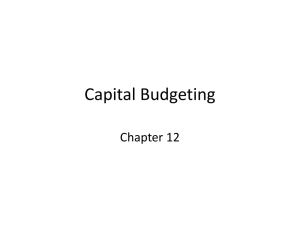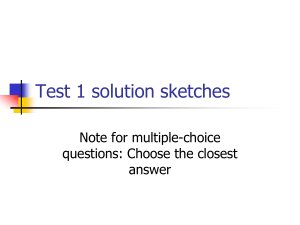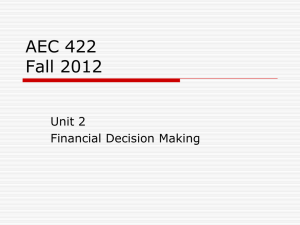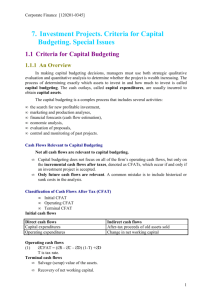CHAPTER 10 The Basics of Capital Budgeting
advertisement
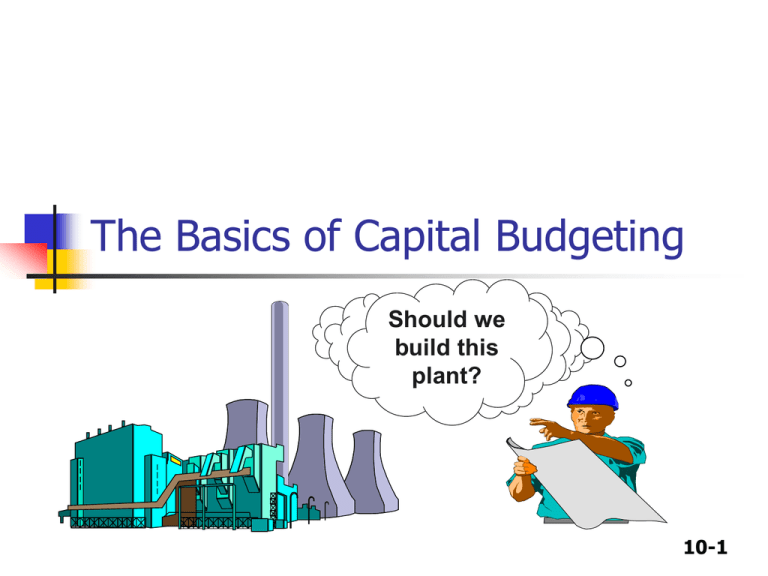
The Basics of Capital Budgeting Should we build this plant? 10-1 What is capital budgeting? Capital Budgeting is the process of evaluating and selecting long term investments that are consistent with the goal pf shareholders wealth maximization. It involves the following actions, Analysis of potential additions to fixed assets. Long-term decisions; involve large expenditures. 10-2 Importance of Capital Budgeting Capital budgeting decisions are of paramount importance in financial decision making, First of all, such decision affects the profitability of a firm because of the fact that they relate to fixed assets. The fixed assets are the true earning assets of the firm. They enable the firm to generate finished goods that can ultimately be sold for profit. Thus capital budgeting decisions determine the future destiny of a firm. 10-3 Importance of Capital Budgeting Secondly, capital expenditure decisions has its effect over long time span and inevitably affect the company's future cost structure. For example, if a particular plant has been purchased by a company to start a new product, the company commits itself to a sizable amount of fixed cost, in terms of labor, insurance, rent, salaries and so on. If the investment turn-out to be unsuccessful in future, the firm will have to bear the burden of fixed costs. In short, future costs, break-even point, sales and profits will all be determined by the selection assets. 10-4 Importance of Capital Budgeting Thirdly, Capital investment decisions, once made are not easily reversible without much financial loss to the firm because there may be no market for second hand plant and equipment and their conversion to other users may not be financially viable. 10-5 Capital Budgeting Process & Its Types Capital Budgeting process refers to the total process of generating, evaluating, selecting and following up on capital expenditure alternatives. There are 3 types of capital budgeting decisions, Accept/Reject decisions The mutually exclusive choice decisions The capital rationing decisions 10-6 Accept/Reject decisions This is the fundamental decision in capital budgeting. If the project is accepted, the firm would invest in it; if the proposal is rejected, the firm does not invest in it. In general, all those proposals which yield a rate of return greater than a certain required rate of return or cost of capital are accepted and the rest are the rejected. By applying this criterion, all independent projects are accepted. 10-7 The Mutually Exclusive choice decisions The Mutually Exclusive projects are those which competes with other project in such a way that the acceptance of one will exclude the acceptance of other projects. The alternatives are mutually exclusive and only one may be chosen. For example, a company is intending to buy a folding machine. There are 3 competing brands each with a different initial investment and operating costs. The 3 machines represent mutually exclusive alternatives and only one of these can be selected. 10-8 The capital rationing decisions It is the financial situation in which a firm has only fixed amount to allocate among competing capital expenditure. The firm allocates funds to projects in a manner that it maximizes long term return. Thus capital rationing refers to a situation in which a firm has more acceptable investments than it can finance. It is concerned with selection of group of investment proposals out of many acceptable under the accept/reject decision. Capital rationing employs ranking of the acceptable investments projects. 10-9 Steps to capital budgeting process 1. 2. 3. 4. 5. 6. Identification of potential investment opportunities Assembling of investment proposals Decision Making Preparation of capital budget and appropriations Implementation Performance Review 10-10 Investment Criteria Investment Criteria Discounting Criteria NPV Benefit Cost Ratio Non-discounting Criteria IRR Payback Period ARR 10-11 Net Present Value The NPV (Net Present value) of a project is the sum of the present values of all the cash flows-positive as well as negative- that are expected to occur over the life of the project. The general formula of NPV is: Ct NPV of Project = (1+r)t initial investment 10-12 Net Present Value where, Ct = Cash flow at the end of the year t n= life of the project r = Discount rate Decision Rule: NPV > Zero = Accepted NPV < Zero = Rejected 10-13 Net Present Value Year Cash Flow 0 Taka(10,00,000) 1 200,000 2 200,000 3 300,000 4 3,00,000 5 350,000 If the cost of capital (r) = 10%. Calculate the NPV. 10-14 Net Present Value NPV = 1000,000 - 300,000 200,000 + 1 (1.10) 200000 + 2 (1.10) 300,000 350000 + (1.10) 3 + (1.10) 4 (1.10) 5 10-15 Net Present Value: Different discount rate Year Cash Flow 0 Taka(12000) 1 4000 2 5000 3 7000 4 6000 5 5000 If the cost of capital (r) = 14%,15%,16%,18%, & 20% respectively. Calculate the NPV. 10-16 Net Present Value: Different discount rate C1= 4000 / 1.14 = 3,509 C2= 5000 / 1.14 x 1.15 = 3,814 C3= 7000 / 1.14 x 1.15 x 1.16 = 4,603 C4= 6000 / 1.14 x 1.15 x 1.16 x 1.18 =3,344 PV of C5= 5000 / 1.14 x 1.15 x 1.16 x 1.18 x 1.20 = 2,322 NPV =3509+3814+4603+3344+2322 – 12,000 = 5,592 PV PV PV PV of of of of 10-17 Benefit Cost Ratio Benefit cost ratio = PVB / I Where, PVB = Present value of Benefits I = Initial Investment Net Benefit Cost ration = BCR – 1 Where, BCR = Benefit cost ration Decision Rule: When BCR >1 <1 or NBCR >0 <0 Rule = Accepted = Rejected 10-18 Benefit Cost Ratio Problem: Let us consider a project which is being evaluated by a firm that has a cost of capital of 12% Initial Investment = Tk. 100,000 Benefits Year 1 25,000 Year 2 40,000 Year 3 40,000 Year 4 50,000 [1] Calculate the Benefit cost ratio [2] Calculate Net Benefit cost ratio 10-19 Benefit Cost Ratio BCR = [25000/1.12 + 40000/(1.12)2+ 40000/(1.12)3+ 50000/(1.12)4] / 100000 = 1.145 NBCR = BCR – 1 = 1.145 – 1 = 0.145 10-20 Internal Rate of Return (IRR) IRR is the discount rate that forces PV of inflows equal to cost, and the NPV = 0 Put differently, it is the discount rate which equates the present value of future cash flows with the initial investment. CFt 0 t ( 1 IRR ) t 0 n 10-21 Internal Rate of Return (IRR) In the NPV calculation we assume that the discount rate (cost of capital) is known and determine the NPV. In the IRR calculation, we set the NPV equal to Zero and determine the discount rate that satisfy this condition. Decision rule If the IRR is > Cost of Capital = Accept If the IRR is < Cost of Capital = Rejected 10-22 Internal Rate of Return (IRR) Problem: year 0 1 2 3 4 Cash flow (100000) 30000 30000 40000 45000 The IRR is the value of r which satisfies the following equations 100,000 = 30000/(1+r)1 + 30000/(1+r)2 + 40000/(1+r)3 + 45000/(1+r)4 The calculation of r involves a process of Trial & Error method. We will try different values of r till we find the right hand side of the above equation is equal to left hand side.10-23 Internal Rate of Return (IRR) Let us, to begin with, Try “r” = 15% 30000/(1.15)1 + 30000/(1.15)2 + 40000/(1.15)3 + 45000/(1.15)4 =100,802 This value is slightly higher than our initial investment[left hand side]. So we will increase the value of r from 15% to 16%. (a higher r lowers and smaller r increases the right hand side value) 10-24 Internal Rate of Return (IRR) Try “r” = 16% 30000/(1.16)1 + 30000/(1.16)2 + 40000/(1.16)3 + 45000/(1.16)4 =98,641 As the value is now less than 100,000, we may conclude that the value of “r” lies between 15% & 16%. If we need more refined estimate of “r”, then use the following procedure 10-25 Internal Rate of Return (IRR) [1] determine the Net present value of the two closest rate of return (100802 – 100000) = 802 (100000 – 98,641) = 1,359 [2] Find the sum of the absolute values of the NPV obtained in step 1. (802+1359) = 2,161. [3] Calculate the ratio of the net present value of the smaller discount rate, 10-26 Internal Rate of Return (IRR) 802/2161 = 0.37 [4] Add the number obtained in step 3 to the smaller discount rate 15+0.37=15.37%. 10-27 Pay Back Period Pay back period is the length of time required to recover the initial cash outlay on the project. The number of years required to recover a project’s cost, or “How long does it take to get our money back?” For Example, if a project involves in cash outlay of Tk. 60000 and generate cash inflow of Tk. 100000,Tk. 150,000 Tk. 150,000 and Tk. 200000 in the 1st,2nd,3rd & 4th year respectively. Its pay back period will be 4 10-28 years. Pay Back Period Because the sum of the cash inflows during 4 years is equal to the initial outlay. When the annual cash inflow is a constant sum the pay back period is simply the initial outlay divided by the annual cash inflow. For example, A project involves in a initial cash outlay of Tk. 1000,000 and a constant annual cash inflow of Tk. 300,000. Calculate the payback period. 1000,000/300,000 = 3 1/3 years. 10-29 Pay Back Period Strengths Provides an indication of a project’s risk and liquidity. Easy to calculate and understand. Weaknesses Ignores the time value of money. Ignores CFs occurring after the payback period. It is a measure of Project’s capital recovery, not profitability. 10-30 Accounting Rate of Return It is also know as average rate of return. Can be defined as Profit after Tax Book value of the investment The numerator of this ratio may be measured as the average annual post tax profit over the life of the investment. The Denominator is the average book value of fixed assets committed to the project. 10-31 Accounting Rate of Return Acceptance/Rejection Criteria The higher the accounting rate of return, the better the project. In general, project’s which have an accounting rate of return equal to or greater than a pre specified cut-off rate of return – which is usually between 10% to 30% are accepted;others are rejected. 10-32 Accounting Rate of Return Year Book Value of fixed Asset 1 2 3 4 5 90,000 80,000 70,000 60,000 50,000 Profit after Tax 20,000 22,000 24,000 26,000 28,000 10-33 Accounting Rate of Return The Accounting rate of Return is (20,000+22,000+24,000+26,000+28,000) 5 (90,000+80,000+70,000+60,000+50,000) 5 = 34% 10-34 Problem: The expected cash flow of a project are as follows Year Cash Flow 0 Taka(100,000) 1 20,000 2 30,000 3 40,000 4 50,000 5 30,000 If the cost of capital (r) = 12%. 10-35 Calculate the NPV. Benefit Cost ratio Net Benefit cost ratio Internal rate of Return Payback Period 10-36





